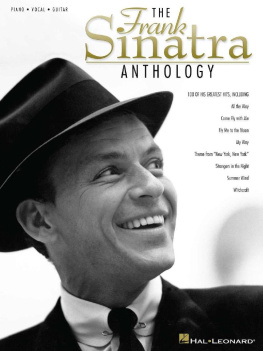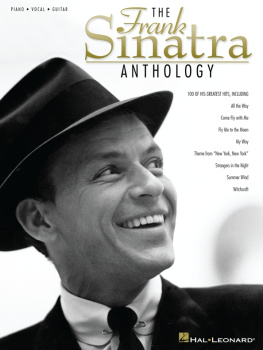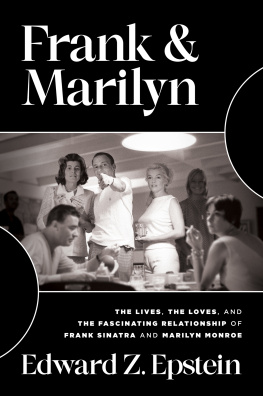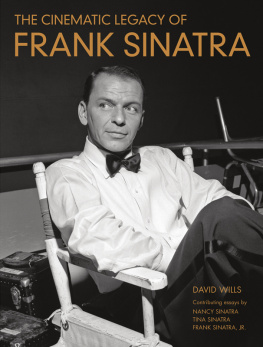Cover photo Herman Leonard Photography, LLC
Photos bearing the PoPsie logo by William PoPsie Randolph www.PoPsiePhotos.com
All other interior photos by Photofest
9781458431646
For all works contained herein:
Unauthorized copying, arranging, adapting, recording or public performance is an infringement of copyright.
Infringers are liable under the law.
Visit Hal Leonard Online at
www.halleonard.com
Frank Sinatra
Francis Albert SinatraOl Blue Eyes, The Chairman of the Board, The Voicewas the greatest singer in American pop history and one of the most successful entertainers of the 20th century. His show business career spanned seven decades and included recordings, film and television, as well as innumerable performances in concert halls, sports stadiums, and nightclubs.
Born December 12, 1915 in Hoboken, New Jersey, Sinatra was the only child of Anthony Martin Sinatra, and his wife, Natalie Garavante, who was called Dolly. As a youngster, Frank dreamed of becoming an engineer and attending the Stevens Institute in Hoboken. That ambition didnt last long once he saw Bing Crosby perform in Jersey City in 1935. He would become a singer, he decided, and Dolly encouraged her sons aspiration.

In 1935, he joined three other young men from his hometown to form a vocal quartet, The Hoboken Four. After a period of time with the group, Sinatra decided to take the solo route, eventually landing a job as a singing waiter who could act as master of ceremonies, at the Rustic Cabin, a roadhouse in Alpine, N.J. His talent attracted the attention of Harry James, the trumpet player who had recently left Benny Goodman to form his own band; James hired Sinatra as the band vocalist. That was in June 1939. Six months later, Tommy Dorsey invited Sinatra to join his band. Frank was delighted and told Dorsey, Ive been trying for years to sing the way you play trombone.
With Dorseys orchestra, the classic Sinatra crooning began and the idol started to form. Six months after joining the ensemble, he scored his first #1 hit, Ill Never Smile Again, a dreamy ballad he sang with the Pied Pipers, the bands vocal group. Sinatra remained with Dorsey from January 1940 to September 1942. In December 1942, determined to be the first singer since Crosby to have a successful solo career, he appeared at the Paramount Theatre in New York City. Benny Goodman was the headliner on the program, with Sinatra billed as an extra added attraction. When the bandleader introduced Mr. Sinatra, the audience erupted into a mass hysteria that made headlines. From 1943 to 1945, The Voice was the lead singer on radios Your Hit Parade. He also had his own show for several years, Songs By Sinatra.
Sinatras recorded legacy reveals a smooth, flexible baritone voice that he used with extraordinary skill. He recorded numerous hits for Columbia Records between 1943 and 1952, but moved to Capitol Records in 1953. His collaborations with arrangers Nelson Riddle and Billy May produced some of the most popular albums of the time, including Songs for Young Lovers , A Swingin Affair , Come Fly with Me , Only the Lonely , In the Wee Small Hours , and Songs for Swingin Lovers . During this period, Sinatra went through a vocal evolution from crooning heartthrob to mature interpretive artist. Across the decades, the long-lined legato phrasing that made bobby-soxers swoon in the 1940s transformed popular singing, giving the lyrics a personal, intimate point of view. During the 1960s, Sinatra established his own recording company, Reprise Records, and released several hit albums, such as Ring-a-Ding-Ding , September of My Years , My Way, and Strangers in the Night . He also starred in a number of award-winning television specials.
A versatile actor as well as singer, Sinatra made his movie debut in 1941 and went on to appear in over 50 films. He won an Oscar for Best Supporting Actor for his portrayal of Maggio, the ill-fated G.I. in From Here to Eternity (1953). He also received a special Oscar for The House I Live In (1945), a 10-minute patriotic plea for racial and religious tolerance. During the course of his movie career, he played everything from a bashful sailor in Anchors Aweigh (1945) to a tormented drug addict in The Man with the Golden Arm (1955; Oscar nomination for Best Actor), a hard Army investigator in The Manchurian Candidate (1962) and a courageous prisoner of war in Von Ryans Express (1965). His impressive filmography also includes On the Town (1945), Guys and Dolls (1955), High Society (1956), Pal Joey (1957), and Oceans Eleven (1960).
In 1971, Sinatra announced his retirement from both recording and acting. He was far from finished, however; in 1973 he released the television special and album Ol Blue Eyes Is Back . He appeared in the urban crime drama The First Deadly Sin in 1980, and made sporadic television and film appearances throughout the decade. The 1990s saw the release of two albums featuring Sinatra with other popular artists of his time, Duets (1993) and Duets II (1994). They outsold any of his previous recordings and proved that his style of music was still in demand.
Sinatra received numerous awards for his philanthropy and charitable deeds. In 1971, he was awarded the Jean Hersholt Humanitarian Award. He received the Kennedy Center Life Achievement Award in 1983 and the Presidential Medal of Freedom in 1985. The NAACP bestowed their Lifetime Achievement Award in 1987. Ten years later, he was granted the Congressional Gold Medal, the highest honor the United States can bestow upon a civilian.
Frank Sinatra has been called the most popular entertainer of the 20th century. Many would label him as one of the most generous philanthropists as well. During his lifetime, he donated more than one billion dollars to charities throughout the world.
Frank Sinatra passed away on May 14, 1998. In a career that spanned 60 years, Sinatra will remain a legend, living on through the body of work he left behind for generations to enjoy.
























